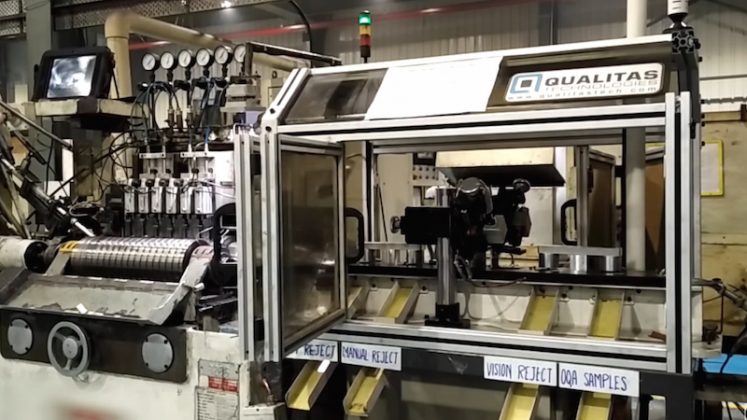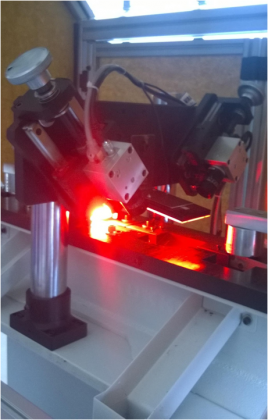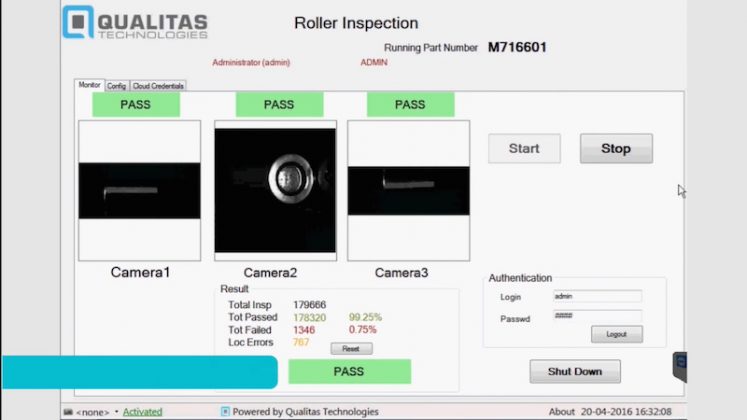Introdução
Os rolamentos são pequenos conjuntos mecânicos de enorme importância. Sua finalidade é reduzir o coeficiente de atrito entre as peças em movimento relativo e garantir a operação estável da máquina a longo prazo. Tanto a superfície do rolamento quanto os rolos do rolamento têm um impacto direto no desempenho de uso, na qualidade e na vida útil do rolamento. Defeitos superficiais comuns, como desgaste, hematomas ou anomalias, podem causar vibração e ruído na máquina, acelerar o desgaste e até mesmo danificar o maquinário. Assim, a inspeção diligente dos rolos de rolamento é de suma importância.
 Embora a maioria dos processos envolvidos na fabricação de rolamentos tenham sido automatizados, a inspeção dos rolos e da superfície dos rolamentos ainda é baseada principalmente na inspeção manual. Tal método de inspeção não é apenas trabalhoso, de baixa eficiência e de alto custo, mas também é facilmente afetado por fatores como a resolução do olho, fadiga e experiência.
Embora a maioria dos processos envolvidos na fabricação de rolamentos tenham sido automatizados, a inspeção dos rolos e da superfície dos rolamentos ainda é baseada principalmente na inspeção manual. Tal método de inspeção não é apenas trabalhoso, de baixa eficiência e de alto custo, mas também é facilmente afetado por fatores como a resolução do olho, fadiga e experiência.
Tipos comuns de defeitos encontrados em rolos de rolamento
Assim como em qualquer outro processo de produção mecânica, os defeitos também são naturais na produção de rolamentos. Sobrecarga, lubrificação inadequada, contaminação e manuseio e instalação incorretos são algumas das principais causas de defeitos nos rolamentos que podem levar à falha. Alguns dos tipos comuns de defeitos de rolamento encontrados em rolos de rolamento foram enumerados abaixo:




Pitting and Contamination
Pitting is damage that is the result of contamination or foreign substances entering the bearing. These include abrasive grit, dirt and dust from contaminated work environments. The primary source of such particles is improperly cleaned housings.
Grinding Damage
Grinding is a common phenomenon observed on rolling surfaces. It can lead to shortened fatigue life and also result in critical failures in dynamically loaded, crucial components.
Shallow Recess
If recesses of the appropriate depth are not in place, the entire ball bearings might not fit as correctly as intended.
Spiral Effect
If the roller bearing possesses any type of defects, an undesirable effect known as the spiral effect is observed.
Defects in any production line are quite natural and a common product of the manufacturing process. It is, however, the responsibility of the manufacturing company to ensure that quality products that meet the compliance standards reach the hands of the customers. The challenge lies in separating the defective pieces from the perfect ones. Let us now look at one of Qualitas Technologies’ clients and study how we helped them overcome their bearing inspection-related issues.
Our Client’s Background
Our client’s forte is engineering, manufacturing, and marketing bearings, gear drives, belts, chains, couplings, lubrication systems, and other associated products. They offer a broad spectrum of powertrain rebuild and repair services. Our client is a key market player in their industry. Being the leading authority on tapered roller bearings, they have been extremely successful in lending their expertise to metallurgy, tribology, and mechanical systems and thus, improving the reliability and efficiency of equipment, vehicles and machinery across the world.
The Chief Issues Our Client Faced
Defects occur naturally on the surface of bearing rollers when in the production pipeline. The common defect categories include damage caused by mechanical collisions, corrosion due to ageing, and material lacking, and grind lacking. These defects are mainly observed on the chamfers, cylindrical surface, and end surfaces.
While our client was well aware of the defects that might pop up in the production process, they had no feasible and effective way of ensuring that each of the defective pieces was successfully separated and discarded. With the production speeds as high as 3 rollers per second, it became quite apparent that human inspectors were incapable of detecting all the defects.
Such issues, if left unaddressed, could have serious repercussions. The low-quality output was damaging the brand image and arousing distrust amongst customers and clients. The defective rollers could lead to leaks, reduced lifespan and lowered efficiency, which was ultimately pushing up the recall rates.
How Qualitas Technologies Helped Solve the Issue of Bearing Inspection & Bearing Roller Inspection
At Qualitas Technologies, we strive to help our clients with an optimized solution at the best possible costs. For this particular client, we suggested the use of AI and machine vision-based technologies to create an automatic bearing inspection and bearing roller inspection process. We implemented the solution by applying our paradigm of the 4I methodology, which is an abbreviation for Install, Instruct, Inspect and Improve.
The core of our solution was implemented in the following way:
Primarily, we installed a set of three cameras at some specific angles and a red panel lighting system to best capture the defects on the rollers. We focused on the use of red lights instead of white lights to minimize the reflection on the bearing surface, which could have resulted in undetected surface defects.
We guided the development of a solution based on the acquired images of the roller defects. We also made sure that each kind of defect was trained (in Qualitas EagleEye® Platform) with the help of a different set of images.
The AI-based Anomaly Detection Technique was used to accurately identify the defects on the roller’s body and face.
Deep Learning (DL) programs were built to train the machine vision system to better understand the different types of surface anomalies on the bearing rollers. Also, the results can be displayed on the user interface in real-time.
Coming up with a system that was fast enough to fit in properly with fast production speeds as well as to train that model to inspect a massive variety of defects while maintaining an accuracy of over 85% was a two-fold challenge. However, using our state-of-the-art technologies and extensive expertise, we succeeded in creating an accurate and fast bearing inspection that was at par with the client’s expectations.
Our machine vision solution was capable of performing accurate defect detection and rejection of defective products. Some prominent features of the inspection procedure are following:
Capable of identifying NCU, shallow recess, grinding damage, and spiral defects with an accuracy of over 98%.
Eliminated the need for staffing out of the inspection loop.
Would enable considerable operational cost savings in the long run.
Permitiu um retorno mais rápido com um tempo de ciclo de inspeção de 150 a 200 milissegundos.
Conclusão
Nesta postagem do blog, entendemos os fundamentos dos rolamentos, a necessidade de inspeção automatizada e os diferentes tipos de defeitos comuns em rolamentos. Também discutimos os problemas enfrentados por um de nossos clientes e como a Qualitas Technologies ajudou na criação de uma solução de sistema de visão adequada.












 Embora a maioria dos processos envolvidos na
Embora a maioria dos processos envolvidos na 


